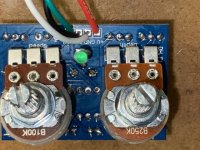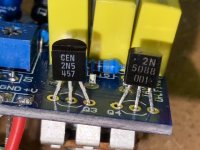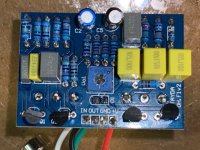Jeff C
Active member
Hoping I don't set another record with this one, but I've just finished building an EA Tremolo from a PCB from Tayda. The Tayda forum is useless. No answers, no activity. So, I hope the patient and helpful folks on this forum who got me eventually across the Cobalt Drive finish line (which by the way sounds fantastic!), can figure out what my problem is. Once I finished it and plugged it in, I got audio but no effects. The LED stays lit up whether the switch is off or on. Volume trimmer potentiometer seems to work fine. I do have the input and output jacks wired correctly  p), and am getting positive (not negative
p), and am getting positive (not negative  ) 9 volts to the board. I've posted four pics below (figured out the magnifying bar on the mag-lite app -doh!). Given my transistor trauma of the Cobalt Drive build, I'm suspicious of mine on this one, so I took some close up pics of those. They Tayda build instructions were confusing. https://www.taydakits.com/instructions/ea-tremolo/pages/designators-and-components--43. For one, it lists a C4 cap, but there is no place for it on the PCB. It also says to use the N5457 and the SMD for Q1 and Q3. Tim (Fig) told me to use one or the other so I used the 2N5457, perhaps unwisely. They look pretty gnarly in the pics.
) 9 volts to the board. I've posted four pics below (figured out the magnifying bar on the mag-lite app -doh!). Given my transistor trauma of the Cobalt Drive build, I'm suspicious of mine on this one, so I took some close up pics of those. They Tayda build instructions were confusing. https://www.taydakits.com/instructions/ea-tremolo/pages/designators-and-components--43. For one, it lists a C4 cap, but there is no place for it on the PCB. It also says to use the N5457 and the SMD for Q1 and Q3. Tim (Fig) told me to use one or the other so I used the 2N5457, perhaps unwisely. They look pretty gnarly in the pics.
Here are some voltage readings from the transistors:
Q1: G: 9.3; S: 5.65; D: 4.46. Q2: E: 2.24; B: 2.8; C: 2.18; Q3: all 0's (hmmmmm); Q4: E: 0; B: 4.61; C: 2.55.
Also, C2 reads 4.4 on the negative pin and 5.6 on the positive one.
I tested with the audio probe and get a signal most everywhere but nada from any of the pot pins.....
Any suggestions on where to start would be appreciated! Tks.
Jeff




Here are some voltage readings from the transistors:
Q1: G: 9.3; S: 5.65; D: 4.46. Q2: E: 2.24; B: 2.8; C: 2.18; Q3: all 0's (hmmmmm); Q4: E: 0; B: 4.61; C: 2.55.
Also, C2 reads 4.4 on the negative pin and 5.6 on the positive one.
I tested with the audio probe and get a signal most everywhere but nada from any of the pot pins.....
Any suggestions on where to start would be appreciated! Tks.
Jeff






